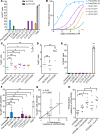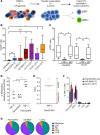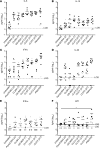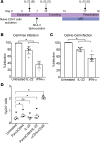Dual TLR2 and TLR7 agonists as HIV latency-reversing agents
- PMID: 30282829
- PMCID: PMC6237480
- DOI: 10.1172/jci.insight.122673
Dual TLR2 and TLR7 agonists as HIV latency-reversing agents
Abstract
The presence of a reservoir of latently infected cells in HIV-infected patients is a major barrier towards finding a cure. One active cure strategy is to find latency-reversing agents that induce viral reactivation, thus leading to immune cell recognition and elimination of latently infected cells, known as the shock-and-kill strategy. Therefore, the identification of molecules that reactivate latent HIV and increase immune activation has the potential to further these strategies into the clinic. Here, we characterized synthetic molecules composed of a TLR2 and a TLR7 agonist (dual TLR2/7 agonists) as latency-reversing agents and compared their activity with that of the TLR2 agonist Pam2CSK4 and the TLR7 agonist GS-9620. We found that these dual TLR2/7 agonists reactivate latency by 2 complementary mechanisms. The TLR2 component reactivates HIV by inducing NF-κB activation in memory CD4+ T cells, while the TLR7 component induces the secretion of TNF-α by monocytes and plasmacytoid dendritic cells, promoting viral reactivation in CD4+ T cells. Furthermore, the TLR2 component induces the secretion of IL-22, which promotes an antiviral state and blocks HIV infection in CD4+ T cells. Our study provides insight into the use of these agonists as a multipronged approach targeting eradication of latent HIV.
Keywords: AIDS/HIV; Immunology; Innate immunity; NF-kappaB; T cells.
Conflict of interest statement
Figures






Similar articles
-
TLR1/2 Agonist Enhances Reversal of HIV-1 Latency and Promotes NK Cell-Induced Suppression of HIV-1-Infected Autologous CD4+ T Cells.J Virol. 2021 Aug 10;95(17):e0081621. doi: 10.1128/JVI.00816-21. Epub 2021 Aug 10. J Virol. 2021. PMID: 34133900 Free PMC article.
-
Maraviroc Is Associated with Latent HIV-1 Reactivation through NF-κB Activation in Resting CD4+ T Cells from HIV-Infected Individuals on Suppressive Antiretroviral Therapy.J Virol. 2018 Apr 13;92(9):e01931-17. doi: 10.1128/JVI.01931-17. Print 2018 May 1. J Virol. 2018. PMID: 29444937 Free PMC article.
-
Toll-Like Receptor 7 Agonist GS-9620 Induces HIV Expression and HIV-Specific Immunity in Cells from HIV-Infected Individuals on Suppressive Antiretroviral Therapy.J Virol. 2017 Mar 29;91(8):e02166-16. doi: 10.1128/JVI.02166-16. Print 2017 Apr 15. J Virol. 2017. PMID: 28179531 Free PMC article.
-
The role of latency reversal agents in the cure of HIV: A review of current data.Immunol Lett. 2018 Apr;196:135-139. doi: 10.1016/j.imlet.2018.02.004. Epub 2018 Feb 7. Immunol Lett. 2018. PMID: 29427743 Review.
-
The Use of Toll-Like Receptor Agonists in HIV-1 Cure Strategies.Front Immunol. 2020 Jun 11;11:1112. doi: 10.3389/fimmu.2020.01112. eCollection 2020. Front Immunol. 2020. PMID: 32595636 Free PMC article. Review.
Cited by
-
Engineering CAR T Cells to Target the HIV Reservoir.Front Cell Infect Microbiol. 2020 Aug 13;10:410. doi: 10.3389/fcimb.2020.00410. eCollection 2020. Front Cell Infect Microbiol. 2020. PMID: 32903563 Free PMC article. Review.
-
Strategies for HIV-1 suppression through key genes and cell therapy.Front Med (Lausanne). 2023 Nov 29;10:1259995. doi: 10.3389/fmed.2023.1259995. eCollection 2023. Front Med (Lausanne). 2023. PMID: 38093984 Free PMC article. Review.
-
A Review of Current Strategies Towards the Elimination of Latent HIV-1 and Subsequent HIV-1 Cure.Curr HIV Res. 2021;19(1):14-26. doi: 10.2174/1570162X18999200819172009. Curr HIV Res. 2021. PMID: 32819259 Free PMC article.
-
Pathways towards human immunodeficiency virus elimination.EBioMedicine. 2020 Mar;53:102667. doi: 10.1016/j.ebiom.2020.102667. Epub 2020 Feb 27. EBioMedicine. 2020. PMID: 32114397 Free PMC article. Review.
-
The Role of Toll-Like Receptors in Retroviral Infection.Microorganisms. 2020 Nov 14;8(11):1787. doi: 10.3390/microorganisms8111787. Microorganisms. 2020. PMID: 33202596 Free PMC article. Review.
References
Publication types
MeSH terms
Substances
Grants and funding
LinkOut - more resources
Full Text Sources
Medical
Research Materials

